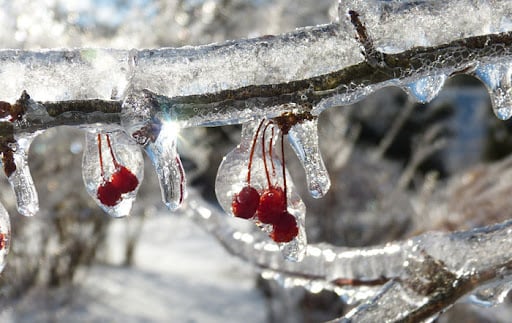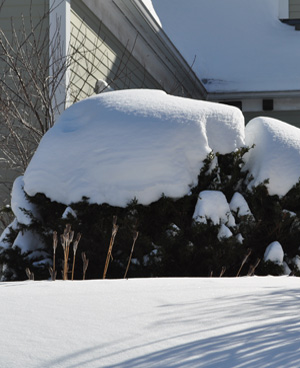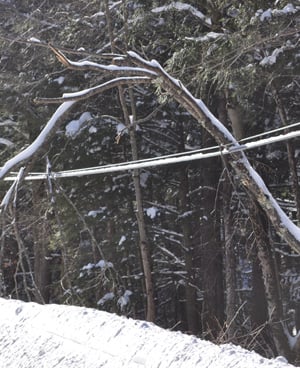How to Care For Trees and Shrubs After A Winter Storm

When a powerful blizzard or winter storm sweeps through your area, the aftermath can leave your yard in disarray, with debris scattered, shrubs buried, and trees damaged. Restoring your landscaping after a winter storm can be a daunting task, but with a systematic approach and proper care, you can revive things.
Tips For Reviving Trees & Shrubs After A Winter Storm

Gently brush snow off shrubs, but let ice melt on its own.
Safety first
Steer clear of hazards, such as downed or sagging power lines, large cracked limbs and trunks, and hanging branches. Notify your utility and seek out the help of a certified arborist before trying to tackle that huge white pine branch laying on the power line.
Remove snow but hold the ice!
Don’t try to remove ice from brittle branches after an ice storm; you’ll likely do more damage than good. Wait for ice to melt naturally on its own. However, if heavy snow is weighing down branches use a broom or your hand to gently brush off snow; brushing upwards is best. If you plan to remove snow, do it immediately after a storm while the snow is still soft.
Assess the damage
Don’t be too hasty to give up on damaged trees and shrubs, because they have remarkable powers of rejuvenation! Wait until spring and see what the plant looks like when it leafs out. Note that it may take a year or two for damaged plants to recover and look normal again. Here are a few hints on assessing your tree:
- Keep: If damage is minor and limited to just a few branches and twigs, prune the broken bits (see below) and allow the tree to heal on its own.
- Wait and see: If you have an especially beloved plant or a tree than still has at least half of its crown, consider waiting until spring. Prune a few snapped branches, step back, and assess again once the tree has had time to recover. If the tree has lost several branches on one side, it may become unstable and a potential hazard.
- Wave goodbye: We know — it can be especially hard for gardeners to take down a tree. However if the trunk is split or more than half of the crown is gone, the tree is a good candidate for removal.
Is the tree far away from major targets (houses, garages, utility lines, play structures)? If so, consider leaving your tree! Dead trees provide unique habitat — birds and small mammals use dead trees for nesting, foraging, and sheltering their young. Birds and bats rely heavily on the insects found in dead trees as a food source. Dead trees help retain soil moisture during dry periods and allowing dead trees to decompose naturally improves the soil through the addition of organic matter and nitrogen-fixing bacteria.
 Fallen limbs should be removed from power lines by a certified arborist or utility company.
Fallen limbs should be removed from power lines by a certified arborist or utility company.Check with your insurance company
Nobody gets excited about making a phone call to the insurance company. However if fallen limbs damaged your house, shed, deck or fence, your homeowner’s insurance may cover the cost of repair or replacement.
Embrace a potential gap in the garden!
Nature (and gardeners) abhor a vacuum, and the empty space that a removed tree creates brings a wealth of new planting possibilities. Embrace this new gap in your yard: Is there now enough sun for a new veggie bed? Have you always dreamed of a vine-covered arbor? Take this as your cue to renvision your yard, expand your garden, or plant a new species of tree.
How To Prune Broken Branches
The ragged edges left when a limb breaks invite disease and insect invasion. Use clean, sharp loppers or a pruning saw to create clean, straight cuts. Leave the branch collar. The raised area where a branch meets the trunk is called the branch collar. When trimming broken branches back to a trunk, leave the branch collar intact to speed healing. Make your cut 1/4″ to 1/2″ outside the collar.
Some types of shrubs, such as lilacs, benefit from “rejuvenation pruning,” where up to one third of the older branches are removed to bring them back to a manageable size and encourage healthy new growth. And a few (but not all!) types of shrubs can be cut back to 12″ to 24″ from the ground and will re-sprout; butterfly bush (buddleia) and smoke bush (cotinus) fall into this category. If the storm has started this rejuvenation pruning, you may as well finish it! Read all pruning advice here: All Pruning Articles
Don't let a winter storm freeze up your garden plans! Prioritize safety and be patient — many of our trees and shrubs and remarkably resilient.
Print this Article:
Get the Dirt
Stay up to date on new articles and advice. Please fill out the information below.
